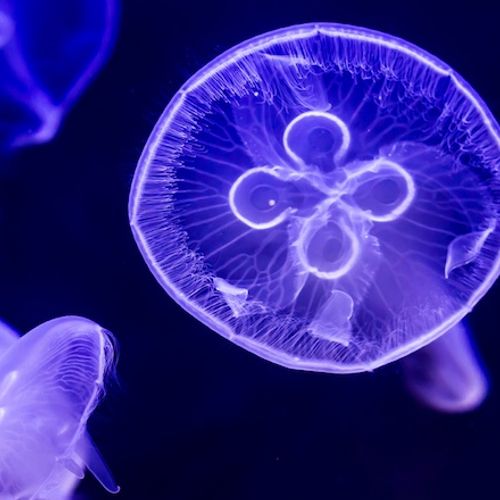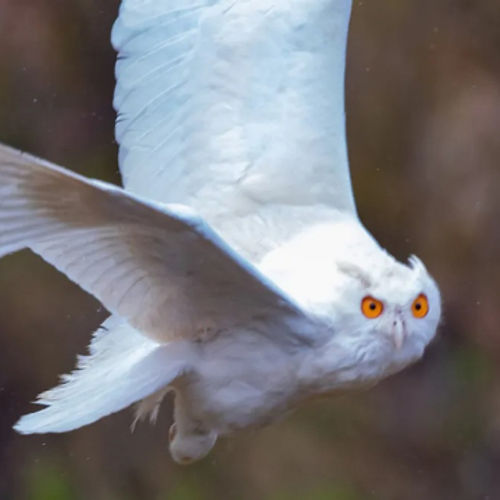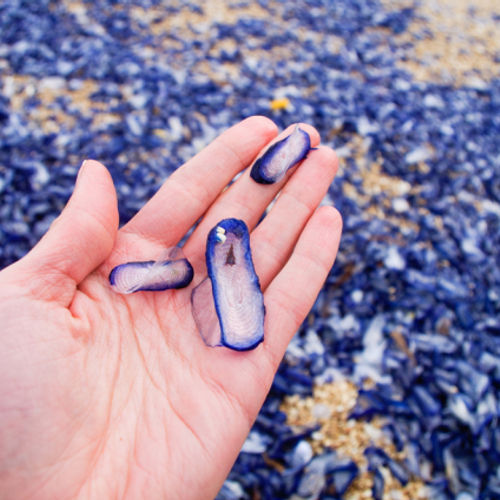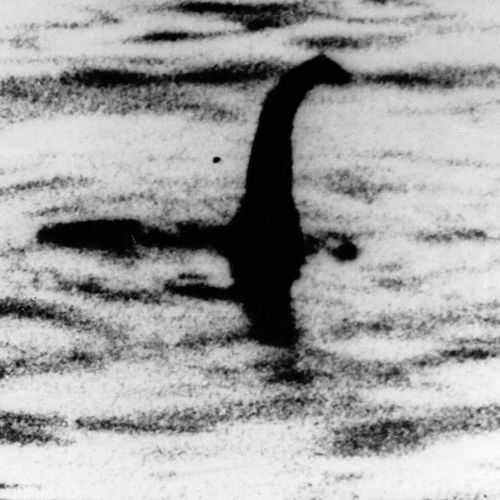
| Added | Wed, 05/06/2019 |
| Источники | |
| Дата публикации | Tue, 04/06/2019
|
| Версии |
When night falls, strange creatures rise from the depths, and the water begins to glow blue. Some phenomena in the ocean can only be seen after dark.
1. The ocean begins to sparkle with bioluminescence
Dinoflagellates emit blue light when touched, as in this Bay on the island of Vaadhoo in the Maldives.
You have probably seen such pictures. On the exotic island it was night. Waves breaking on the beach. The water sparkles blue, like electricity color.
The Internet is very like the photographs of this magical bioluminescent Bay. Perhaps you've heard stories of bloggers who say that everything in life is not so magical. Even if it did, bioluminescence (in this case caused by the special plankton called dinoflagellates) is a stunning phenomenon of nature.
Dinoflagellates emit blue light only when you touch it, so they can only be seen on the crest of a wave, around the boats, and when the paddle touches the water. These tiny creatures — the main source of bioluminescence on the ocean's surface.
The so-called bioluminescent bays, such as Puerto Rico or Jamaica, is the most famous place to watch it glow. However, this ephemeral phenomenon can be found in many other areas of the ocean where the density of dinoflagellates is particularly high.
Sometimes the population of dinoflagellates is increasing too quickly, and it will then be a much less beautiful glow that day has a red-brown color, also known as "red tide". And some of these dinoflagellates are even poisonous.
Even more rare and unusual than the bioluminescent bays, is the milky glow of the sea, when illuminated water stretches to the horizon.
Milky glow of the sea managed to fix only a few hundred times since 1915, the bulk of them were concentrated in the northwestern part of the Indian ocean and around the Indonesian island of Java. This phenomenon is not explained by dinoflagellate, but rather "bioluminescent bacteria, many of which gathered on the surface of the water," explains Dr. Matt Davis, associate Professor of biology University St. cloud, USA, which specializiruetsya on bioluminescence.
For centuries sailors have described the milky glow of the sea as night, a whitish glistening like snow, but scientists have not been able to study in detail this phenomenon.
In 2005, researchers analyzing archived satellite pictures, found that the milky glow of the sea can be observed from space and that one satellite detected a huge area in the ocean, which had a strange glow for three nights in a row a decade earlier.
2. Animals glow in the dark
Bioluminescence, the emission of visible light by the body in result of natural chemical reactions, characteristic of marine animals such as fish, squid and shellfish. In the deep waters of most species are bioluminescent, and are the main source of light.
In shallow water most of the bioluminescent fish emit light only at night.
"I phonerelated fish have a special organ under the eye, which they can rotate, to emit light from bacteria [accumulates in the body], and they use it to hunt and communicate with other animals," says Matt Davis.
Masking, protection, hunting is one of the reasons why fish emit light. Squid, for example, light uses a very sophisticated way. These nocturnal animals mutually beneficial relationships with luminescent bacteria that accumulate in their mantle. Using them at night, the squid control their color depending on the brightness of the light of the moon, and thus reduce their to disguise itself from predators.
3. The light of the moon provokes the greatest on the planet in an Orgy
There is nothing more romantic than moonlight, especially if you have coral on the Great Barrier reef. One night a year, every spring, the moonlight provokes the world's largest Orgy. More than 130 species of coral simultaneously release in water sex cells during the interval of 30-60 minutes.
Mass reproduction on the Great Barrier reef is one of the most extraordinary examples of synchronized behavior on earth.
When sex cells, sperm and eggs available, they are for a second crash, creating a ghostly semblance of the shape of the reef, before you dive into an underwater storm fertilization.
Dr. Levi Yelled, a marine biologist and ecologist and Professor of Bar-Ilan University, Israel, studied this extraordinary phenomenon.
"It's really an amazing phenomenon ... we know that this event happens every year in November, a few nights after the full moon, usually in 3-5 days, he says. — It is always incredibly in particular every time I marvel at how the types of corals year after year at the same time multiply in the night in the same hour."
He adds:
"As soon as this happens to me every time shakes, as everything becomes so alive and synchronized. It is almost a spiritual experience, when you begin to understand the power of nature in all its glory. The moon triggers this phenomenon, as it serves as the synchronizer and a kind of "alarm clock" most likely in conjunction with other environmental phenomena such as sunset time, water temperature and tide, to signal to the isolation of germ cells (sperm and egg)".
It is likely that corals have photoreceptors that define the phases of the moon, knowing therefore when to release sex cells.
4. Sharks and seals rely on the light of heaven
For many seals nights with the moon means danger. In the winter months, about 60 000 Cape fur seals on the island si, false Bay, South Africa, are at risk of being eaten by a great white shark, who were watching seals at the entrance and exit from the water.
According to a study conducted in 2016, it has been hypothesized that swimming at night in the full moon, the cats are at greater risk to be eaten by sharks, as the bright moonlight highlights their silhouette on the surface, making them easy prey for predators under water. However, the majority of shark attacks on seals occur at dawn. Researchers who studied the attacks on dawn were surprised at the full moon in the morning predators hunted smaller. The researchers theorized that the moonlight together with starting sunlight could reduce the hunting ability of the sharks, and at that time they had no advantage over the lions.
Also the seals could focus on another parameter — the stars. Common seals (Phoca vitulina) can detect where is North star and follow it, the research shows. During the experiment using a simulated night sky, the seals swam toward the brightest star.
In the wild, the seals need to move across the open sea to find a place of feeding, which could be located hundreds of kilometers away.
Researcher Dr Bjorn IOC expressed at the time: "Seals can memorize the location of stars in relation to the place of feeding at dusk and dawn, when they see the stars, and the earth."
5. Unusual animals rise to the surface every night
Under cover of night animals, which are rare, to migrate to the surface of the ocean in search of prey. The Humboldt squid is one of the most exciting sea animals that can be seen on the surface of the water.
During the day he usually lives in the depths of the Eastern Pacific ocean in the waters of a deepwater shelf off the West coast of North and South America, and every night he, like many other marine animals, migrates upward in search of food. Vertical migration is a process where marine animals rise to the surface at sunset and again fall to depth at dawn. This phenomenon — the phenomenon is very widespread.
"Squid Humboldt follows its main prey, the so-called luminous anchovies," explains Professor Paul Rothaus, Emeritus Professor of the British Institute for the study of the Antarctic and the former head of its Department of biological Sciences. As luminous anchovies, in turn, follow vertically migrating zooplankton. Since zooplankton depend on many marine animals, "the remaining links in the food chain will follow," says Professor Rothaus.
"This is a huge daily movement of biomass," explains Radhaus. "More than a thousand meters. Some squid migrate more than a kilometer a day."
The Humboldt squid is one the most stunning views, rising to the water surface every night. For its ability to change color and glow a bright red called "red devil". And despite the fact that they are less a 13-metre giant squid, they can reach five feet in length. These very aggressive predators that capture food strong tentacles and suckers and break their teeth. Even in history there have been several attacks on people.
But even these ferocious animals become victims of even larger predators, such as swordfish or shark.
"Of course, they are all active at night to avoid the attacks of larger predators, says Professor Rothaus — Thus, to reduce the risk of being eaten, they must descend into the deep dark waters of the night."
Translated by «Yandex.Translator»
© Richard A McMillin | shutterstock
Translated by «Yandex.Translator»
Новости со схожими версиями
Log in or register to post comments









